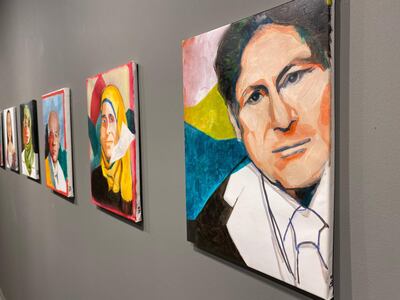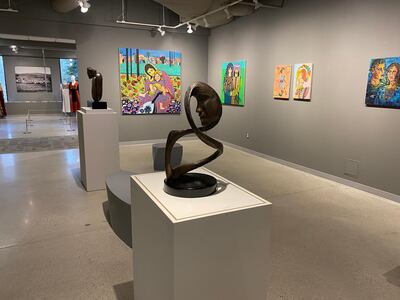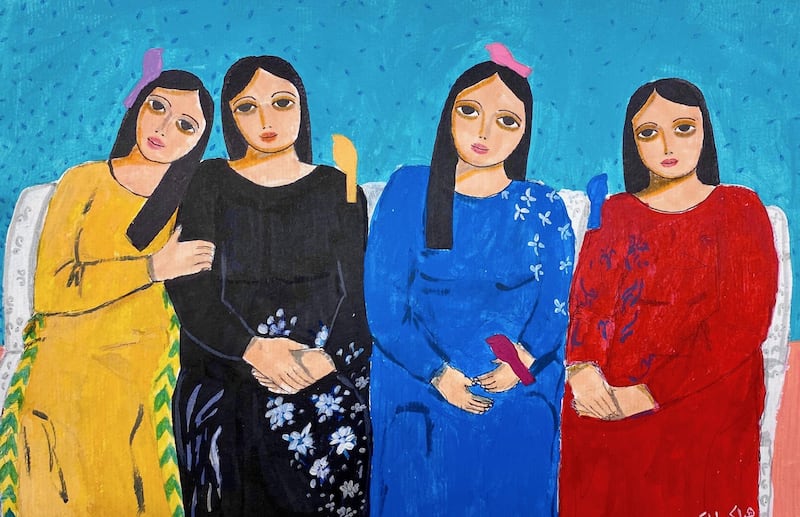March is truly set to be a month of Sundays. Last Sunday marked the beginning of Women's History Month and today is International Women's Day. In honour of both, the Palestine Museum US in Woodbridge, Connecticut, will be encouraging visitors to immerse themselves in the artworks of 50 female Palestinian artists from around the world every Sunday until the end of May.
The exhibition Telling the Palestinian Story, which opens today, features more than 200 works of art, spanning painting, sculpture, photography, textiles and mixed media. The participating artists, many of whom will be exhibiting their work in the US for the first time, are from 14 countries on five continents, including the US and Canada, Palestine, Kenya, Chile, Germany and the UK.
"The mission of the museum is to showcase Palestinian artistic excellence and we wanted to focus the light on Palestinian women because they have received little attention in the West," says Palestinian-American entrepreneur Faisal Saleh, the museum's founder and manager.
For Saleh, the narrative of Palestinian art has mainly been dominated by men. "We wanted to change the conversation and bring women into focus – and what better time to do it than International Women's Day?"
The artists chosen to exhibit range, says Saleh, from the "extremely accomplished and world renowned, like Samia Halaby, to artists nobody has heard of," but who are particularly talented. "I was very selective in which artists we invited, but not to the point of ignoring up-and-coming young artists who are still developing," says Saleh.
Halaby, a multimedia artist who lives in New York, is showing several colourful abstract paintings. Other prominent artists featured in the exhibition include Palestinian-American artist Manal Deeb, who was born in Ramallah but lives in Washington, DC, and addresses themes of exile in her work, and London artist Laila Shawa, whose art often has political undertones, tackling injustice and persecution. Other artists include Haya Kaabneh, who lives and works in Palestine. Her work is inspired by true stories of the country's women. She paints them in watercolours and they are a metaphor for the difficulty that women encounter. Her subject's faces are often depicted as saddened or forlorn, owing to the hardships of life under occupation.
The works vary in theme, size and style – from paintings to sculptures. Some portray Palestinian identity visibly through symbols while others are more subtle.

The non-profit museum, which opened in April 2018, is the first in the western hemisphere dedicated to Palestinian art and culture. The exhibition fills all eight of its galleries, which include three large spaces and five smaller ones, some of which are dedicated to a single artist. The show's curator, Nancy Nesvet, who recently joined the museum staff, says the diversity of work on view reflects the breadth of the Palestinian diaspora.
"One interesting thing about this exhibition is the variance of media and a lot of it relates to the idea of Palestine, to the history of Palestine, [such as] using gold threads and patterns from tatreez – traditional embroidery motifs – but that comes into paintings, that comes into multimedia works," she says.
"One artist made canvas thobes that stand as sculptures and are inscribed with tatreez patterns that are contemporary and abstract, so that she – and any number of these artists – are taking the folk traditions of Palestine and layering them [with modern elements], bringing Palestinian art into the diaspora."
The canvas thobes, by New Jersey artist Samar Hussaini, are displayed in their own gallery space. Deeb, who is showing a set of semi-abstract paintings titled From Here to There, that draws on the power and motion of Arabic calligraphy embedded with imagery to evoke the experience of the Palestinian diaspora. The artist has also been given her own space in one of the smaller galleries. Nesvet has arranged works by theme and has used colour to lead visitors through the space, seeking to create an immersive experience.
Thematically, the show is also diverse, encompassing figurative and abstract works, landscapes and cityscapes ranging in style from Realism to Semi-Abstraction, and works depicting historical events and figures, including a portrait series by Luxembourg artist Jacqueline Bejani that depicts famous Palestinians, both living and dead – such as the late Palestinian-American thinker Edward Said.
Saleh emphasises that while many of the works have a connection to Palestine, the links are not always obvious at first glance. "A good part of the work is that you can't tell it's Palestinian by looking at it – and that's intentional," he says. "We weren't necessarily looking for Palestinian art that's full of flags and things like that. We wanted the art to be subtle. Really, the story that's being told here, is that the Palestinians exist, they're talented and they're just like any other people. They're human and they need to be recognised as humans and treated accordingly."
Opening less than six weeks after US President Donald Trump and Israeli Prime Minister Benjamin Netanyahu unveiled a Middle East peace plan that was widely reviled by Palestinians globally, Saleh says that the exhibition is "a way to prove the existence of the Palestinians at a time when their existence is being attacked and denied."

Falling in the middle of the exhibition's run, Palestine Art Week, a digital initiative launched by the museum last year, aims to amplify the voices of Palestinians around the world. "It's an annual virtual event where people join and post about Palestinian art – their favourite artists, their favourite paintings – and we create a global social media storm about Palestinian art," says Saleh, who has scheduled the second iteration from Friday to Monday, April 24 to 30.
When the exhibition opens today, he plans to use a digital platform to forge links between all 50 participating artists. "At the opening ceremony we're going to have a Zoom video conference and we're going to bring the 50 artists from around the world into a single conference and create a sense of community and unity," he says.
“One of the objectives is to strengthen the Palestinian identity through the arts and create a common effort, regardless of where they’re located and regardless of their political or economic divisions, so that there will be one Palestinian art voice.”
Telling the Palestinian Story is open every Sunday and by appointment until Friday, May 30. More information is at www.palestinemuseum.us






